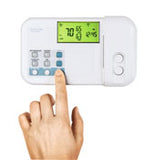 One way to help lower the particle count in your home is to use high-efficiency home air filters in your home’s heating, ventilation and air conditioning system, known as your HVAC.
One way to help lower the particle count in your home is to use high-efficiency home air filters in your home’s heating, ventilation and air conditioning system, known as your HVAC.
What is HVAC?
It is a common misconception to consider the air filter inside a home’s heating, ventilation and air conditioning system (also known as an HVAC) to be the most affordable and effective way of filtering your air. HVAC filters provide minimal filtration of airbone particles and deliver the air in a dispersed manner at a relatively slow rate. For maximum performance of your home HVAC system and to maintain energy efficiency levels, you should replace your filter at least every three months.
HVAC filters come in different MERV ratings. A higher MERV rating means a tighter weave, which removes smaller airborne particles than a filter with a loose weave. However, a higher MERV rating also means the filter creates more resistance to the air flowing through. This can cause more wear on your HVAC’s motor and yield higher energy costs.
HVAC vs HEPA
Even with high quality HVAC filters and frequent filter changes, HVAC air filters are made to trap only large particles in the air, missing small particles and not truly cleaning the air. In addition, since an HVAC system delivers either warm or cool air to your home, it is primarily designed to regulate airflow and temperature, rather than to filter airborne particles out of the air. A free-standing air purifier is capable of targeting smaller particles, and an air purifier with a HEPA filter will remove up to 99.97% of allergens, including dust and mold particles. An air purifier can also be used to target specific concerns or specific areas of your home where allergens and other particles are more prevalent, like living rooms and bedrooms.

 One way to help lower the particle count in your home is to use high-efficiency home air filters in your home’s heating, ventilation and air conditioning system, known as your HVAC.
One way to help lower the particle count in your home is to use high-efficiency home air filters in your home’s heating, ventilation and air conditioning system, known as your HVAC.